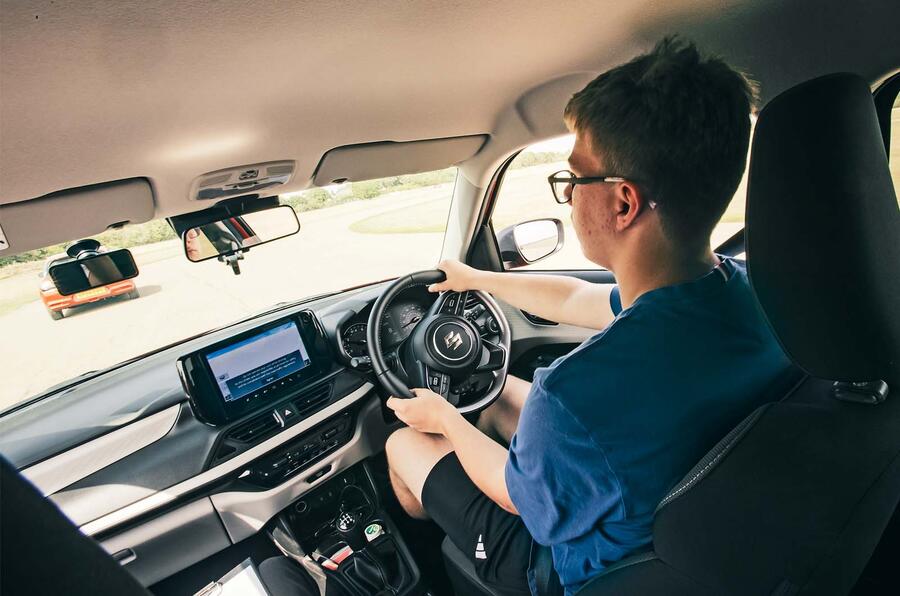It can be L dealing with our writers on shoots. Just ask learner driver Freddie…
Demand for driving tests has never been greater, so passing first time is crucial
With the average waiting time to take their driving test standing at 22.2 weeks, there’s huge pressure on new drivers to pass first time.
Test dates are released on Monday mornings and there is fierce competition for them from other candidates and from instructors but, worse, from third-party firms who use automated software to hoover up dates for resale.
What can the new driver do to ensure they pass their test first time and put the waiting game behind them? Simply, learn with the best instructor they can find.
Personal recommendation is a good idea but, fortunately, establishing the competence of an instructor is pretty straightforward because the DVSA, which trains and certifies them, also tests and grades them at intervals.
A driving instructor who has achieved a score of between 43 and 51 in their most recent assessment has demonstrated a high standard of instruction and is a Grade A. A Grade B instructor, the majority, is one who has scored 31 to 42 and so is judged to have performed only to a satisfactory standard.
An instructor performing worse than this earns a Fail. Only Approved Driving Instructors (ADIs) can be awarded these grades. To find out what grade an instructor is, ask them or check their website.

In addition to ADIs there are Potential Driving Instructors (PDIs). They are training to be ADIs and have passed the first two parts of their three-part ADI qualification programme, granting them a six-month licence to teach. In their favour, they will be cheaper than an ADI and might be brimming with freshly learned ideas and training.
However, unless a PDI qualifies as an ADI during their six-month training period, their licence could expire before the learner driver has completed their lessons. Also, faced with a learner who has no prior driving experience and who requires experienced coaching, a PDI may be out of their depth.
But what young learner has had prior driving experience? In fact, quite a few thanks to an organisation called Young Driver. Launched in 2010, it has so far delivered 1.6 million driving lessons to young children aged from four years up to teenagers no older than 17.
Even the youngest learners receive basic tuition in handling one of Young Driver’s miniature Firefly Sports, but by the time they are old enough (nine years and upwards) to drive a dual-control Suzuki Swift, the real work begins with an ADI instructor coaching them almost to driving test standard.
‘Almost’ because in the off-road areas where lessons are conducted, it’s impossible to recreate the myriad of situations that learners will face on the public highway.
Still, they have a good try with the result that of the 17-year-old former Young Driver students who went on to have formal lessons and took their driving test in the past 12 months, 78.2% passed first time compared with the national average of 48%.

Remarkably, they did so on, typically, 10 hours of formal lessons (plus those they had as students of Young Driver) compared with the 45 hours most other candidates require. More important, while 20% of young drivers have a crash within the first six months of passing their test, just 3.4% of former Young Driver students do.
They are persuasive figures but exactly how good is a 16-year-old Young Driver student behind the wheel? To find out, I pitched myself against one in a mock driving test judged by John Bennett, an ADI Grade A Young Driver instructor.
Our ‘duel’ (because to me, with 44 years of driving under my belt and a point to prove, that’s what it was) was held at Young Driver’s Bicester Motion venue during a regular training event attended by around 170 youngsters keen to drive the 25 Swifts available. Freddie, my ‘adversary’, was a veteran of Young Driver with 10 hours of tuition in his lesson book.
He will be 17 on 1 January and has already booked his theory test but can’t book his driving test until then. Will he pass it first time? Success today would be a good indicator…
I went first so, with John in the passenger seat to guide me, I took the Swift for a quick recce of the course: a sinewy affair laid out with cones and road signs. Then it was time for the test.

It lasted 30 minutes and at the end John talked me through my five ‘minors’, which included insufficient observation during a manoeuvre, poor positioning and moving off without sufficiently considering an approaching Swift.
Still, only five… Surely, Freddie wouldn’t beat that? Off he went with John. It felt like they were gone longer, which gave me grounds for optimism. However, on their return, John said to Freddie: “You did very well. You’re ready for the road.”
Not what I wanted to hear but then Freddie broke the news that he had amassed 10 minors, although you’re allowed 15 in the test.
So, a win for me but a cracking result for Freddie who, bolstered by perhaps 10 further hours of on-road tuition once he turns 17, could well be tearing up his L-plates next June.
